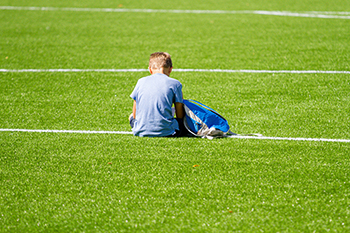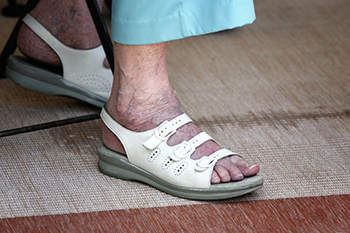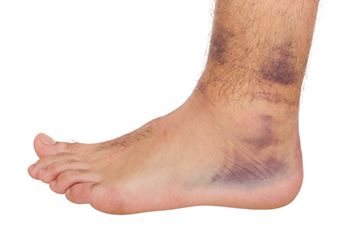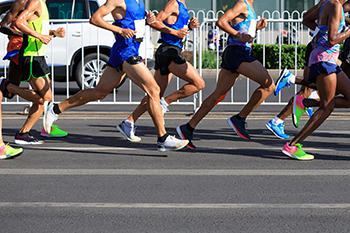Items filtered by date: June 2024
Foot and Ankle Injuries in Young People Who Play Sports
 Foot and ankle injuries are common among kids and adolescents who play sports, ranging from congenital variants to acute and chronic injuries. Congenital variants can include structural abnormalities present at birth. Osteochondroses, a group of disorders affecting the growth of bones in children and adolescents, can cause pain and swelling. Acute injuries, such as fractures and sprains, and chronic injuries, like stress fractures and tendonitis, are prevalent due to the repetitive stress of sports activities. Soft tissue injuries, including strains and ligament tears, are also frequent. Additionally, infections can complicate injuries if not properly treated. Podiatrists must consider systemic diseases such as inflammatory arthritis when a pediatric athlete presents with unexplained pain and swelling in one or more joints. Adolescents tend to sustain more injuries than younger children due to their increased participation in high-intensity sports and the physical changes during growth spurts. If your child has sustained a foot or ankle injury from playing sports or complains of associated pain, it is suggested that you schedule an appointment with a podiatrist for a proper diagnosis and treatment.
Foot and ankle injuries are common among kids and adolescents who play sports, ranging from congenital variants to acute and chronic injuries. Congenital variants can include structural abnormalities present at birth. Osteochondroses, a group of disorders affecting the growth of bones in children and adolescents, can cause pain and swelling. Acute injuries, such as fractures and sprains, and chronic injuries, like stress fractures and tendonitis, are prevalent due to the repetitive stress of sports activities. Soft tissue injuries, including strains and ligament tears, are also frequent. Additionally, infections can complicate injuries if not properly treated. Podiatrists must consider systemic diseases such as inflammatory arthritis when a pediatric athlete presents with unexplained pain and swelling in one or more joints. Adolescents tend to sustain more injuries than younger children due to their increased participation in high-intensity sports and the physical changes during growth spurts. If your child has sustained a foot or ankle injury from playing sports or complains of associated pain, it is suggested that you schedule an appointment with a podiatrist for a proper diagnosis and treatment.
Ankle and foot injuries are common among athletes and in many sports. They can be caused by several problems and may be potentially serious. If you are feeling pain or think you were injured in a sporting event or when exercising, consult with one of our podiatrists from Barry University Foot and Ankle Institute. Our doctors will assess your condition and provide you with quality foot and ankle treatment.
Common Injuries
The most common injuries that occur in sporting activities include:
- Achilles Tendonitis
- Achilles Tendon Rupture
- Ankle Sprains
- Broken Foot
- Plantar Fasciitis
- Stress Fractures
- Turf Toe
Symptoms
Symptoms vary depending upon the injury and in some cases, there may be no symptoms at all. However, in most cases, some form of symptom is experienced. Pain, aching, burning, bruising, tenderness, tightness or stiffness, sensation loss, difficulty moving, and swelling are the most common symptoms.
Treatment
Just as symptoms vary depending upon the injury, so do treatment options. A common treatment method is known as the RICE method. This method involves rest, applying ice, compression and elevating the afflicted foot or ankle. If the injury appears to be more serious, surgery might be required, such as arthroscopic or reconstructive surgery. Lastly, rehabilitation or therapy might be needed to gain full functionality in the afflicted area. Any discomfort experienced by an athlete must be evaluated by a licensed, reputable medical professional.
If you have any questions, please feel free to contact our offices located in Miami, North Miami Beach, Miami Beach, and Tamarac, FL . We offer the newest diagnostic and treatment technologies for all your foot care needs.
Aging and the Feet
 As the aging population continues to grow, the need for specialized podiatric services in geriatrics is becoming increasingly critical. Older adults often face numerous foot and ankle issues due to years of wear and tear, decreased mobility, and chronic conditions like diabetes, arthritis, and circulatory problems. These issues can significantly impact their quality of life, leading to pain, decreased mobility, and a higher risk of falls and related injuries. Podiatric care is essential for the elderly to maintain their independence and mobility. Regular foot examinations can help prevent and manage conditions, such as bunions, corns, calluses, fungal infections, and foot ulcers. Proper foot care also aids in the early detection and treatment of serious complications such as peripheral neuropathy and poor circulation, which are common in older adults with diabetes. Preventative measures, routine care, and wearing appropriate footwear are vital components of geriatric podiatry services. If you are a senior, it is suggested that you schedule an appointment with a podiatrist for comprehensive foot health management, and to address any specific concerns you may have about your feet or ankles.
As the aging population continues to grow, the need for specialized podiatric services in geriatrics is becoming increasingly critical. Older adults often face numerous foot and ankle issues due to years of wear and tear, decreased mobility, and chronic conditions like diabetes, arthritis, and circulatory problems. These issues can significantly impact their quality of life, leading to pain, decreased mobility, and a higher risk of falls and related injuries. Podiatric care is essential for the elderly to maintain their independence and mobility. Regular foot examinations can help prevent and manage conditions, such as bunions, corns, calluses, fungal infections, and foot ulcers. Proper foot care also aids in the early detection and treatment of serious complications such as peripheral neuropathy and poor circulation, which are common in older adults with diabetes. Preventative measures, routine care, and wearing appropriate footwear are vital components of geriatric podiatry services. If you are a senior, it is suggested that you schedule an appointment with a podiatrist for comprehensive foot health management, and to address any specific concerns you may have about your feet or ankles.
If you need your feet checked, contact one of our podiatrists of Barry University Foot and Ankle Institute. Our doctors will attend to all of your foot and ankle needs and provide you with quality treatment.
Geriatrics and Podiatry
When people age, some common issues that may occur are bone density loss, dry skin, poor circulation, and rough brittle nails. These issues may also affect your foot health if the necessary steps are not taken to alleviate the problems.
It is important to take care of your feet because feet that are injured or diseased can affect your overall health. Having painful feet hinders your ability to do daily activities or may decrease your willingness to do the things that you need to do.
Visiting Your Geriatrician
As we age, health problems become more likely, so it is essential to visit your doctor for check-ups to ensure that you are doing the best you can to take care of your health. It is recommended to check your feet frequently for any possible cuts, bruises, swelling, corns or any other irregularities.
Taking Care of Elderly Feet
Cracked or dry feet can be treated by applying moisturizer often. It is also important not to wear old socks because the older the sock is, the higher the possibility there will be that there is bacteria there. Wear fresh socks and make sure they fit properly.
Proper foot health means that you can have a more active lifestyle and you will not be bogged down by pain. Foot health also leads to good circulation, which is paramount for overall health.
If you have any questions, please feel free to contact our offices located in Miami, North Miami Beach, Miami Beach, and Tamarac, FL . We offer the newest diagnostic tools and technology to treat your foot and ankle needs.
High Ankle Sprains in Athletes

High ankle sprains, prevalent among athletes, are distinct from traditional ankle sprains due to the affected ligaments. These injuries typically occur during sudden twists or impacts that force the foot upwards, straining the ligaments connecting the two lower leg bones, the tibia, and fibula. These are unlike common ankle sprains, which involve the ligaments on the sides of the ankle. The injury causes pain, swelling, and instability, hindering mobility and performance. Sports that involve rapid changes in direction or jumping, such as basketball, soccer, and football, pose a higher risk. Factors like insufficient warm-up, wearing improper footwear, and fatigue exacerbate the likelihood of injury. Timely diagnosis and appropriate treatment, including rest, compression, and elevation, are critical for recovery and prevent long-term complications in athletes. If you have suffered an ankle sprain during a sporting activity, it is suggested that you consult a podiatrist who can determine which type of sprain it is, and treat it accordingly.
Ankle sprains are common but need immediate attention. If you need your feet checked, contact one of our podiatrists from Barry University Foot and Ankle Institute. Our doctors can provide the care you need to keep you pain-free and on your feet.
How Does an Ankle Sprain Occur?
Ankle sprains take place when the ligaments in your ankle are torn or stretched beyond their limits. There are multiple ways that the ankle can become injured, including twisting or rolling over onto your ankle, putting undue stress on it, or causing trauma to the ankle itself.
What Are the Symptoms?
- Mild to moderate bruising
- Limited mobility
- Swelling
- Discoloration of the skin (depending on severity)
Preventing a Sprain
- Wearing appropriate shoes for the occasion
- Stretching before exercises and sports
- Knowing your limits
Treatment of a Sprain
Treatment of a sprain depends on the severity. Many times, people are told to rest and remain off their feet completely, while others are given an air cast. If the sprain is very severe, surgery may be required.
If you have suffered an ankle sprain previously, you may want to consider additional support such as a brace and regular exercises to strengthen the ankle.
If you have any questions please feel free to contact our offices located in Miami, North Miami Beach, Miami Beach, and Tamarac, FL . We offer the newest diagnostic and treatment technologies for all your foot and ankle needs.
Pain on Top of Your Foot

Feeling a sharp pain on the top of your foot during each step can be disconcerting, especially for runners. Unlike more recognizable running injuries, such as plantar fasciitis or shin splints, top-of-foot pain poses a unique challenge for diagnosis. Types of pain on the top of the foot among runners include tendonitis, metatarsal stress fractures, or neuromas. Tendonitis may cause pain near the instep and big toe, and is often accompanied by shin splints. Metatarsal stress fractures, often triggered by sudden increases in training intensity, result in swelling and discomfort over the metatarsal bones. The second and third metatarsals of the foot, which are thinner, and often longer than the first metatarsal, are most prone to stress fractures. This is the area of greatest impact on your foot when you push off to run. Wearing tight footwear can lead to issues like vamp disease or neuromas, resulting in pain or burning sensations that may be relieved by adjusting shoe fit. Regardless of the suspected injury, if the pain persists despite rest, it is suggested that runners consult a podiatrist promptly for an accurate diagnosis and suggested treatment options.
All runners should take extra precaution when trying to avoid injury. If you have any concerns about your feet, contact one of our podiatrists of Barry University Foot and Ankle Institute. Our doctors will treat your foot and ankle needs.
How to Prevent Running Injuries
There are a lot of mistakes a runner can make prior to a workout that can induce injury. A lot of athletes tend to overstretch before running, instead of saving those workouts for a post-run routine. Deep lunges and hand-to-toe hamstring pulls should be performed after a workout instead of during a warmup. Another common mistake is jumping into an intense routine before your body is physically prepared for it. You should try to ease your way into long-distance running instead of forcing yourself to rush into it.
More Tips for Preventing Injury
- Incorporate Strength Training into Workouts - This will help improve the body’s overall athleticism
- Improve and Maintain Your Flexibility – Stretching everyday will help improve overall performance
- “Warm Up” Before Running and “Cool Down” Afterward – A warm up of 5-10 minutes helps get rid of lactic acid in the muscles and prevents delayed muscle soreness
- Cross-Training is Crucial
- Wear Proper Running Shoes
- Have a Formal Gait Analysis – Poor biomechanics can easily cause injury
If you have any questions, please feel free to contact our offices located in Miami, North Miami Beach, Miami Beach, and Tamarac, FL . We offer the newest diagnostic and treatment technologies for all your foot care needs.
